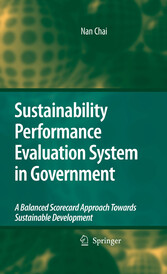Suchen und Finden
Mehr zum Inhalt

Sustainability Performance Evaluation System in Government - A Balanced Scorecard Approach Towards Sustainable Development
Foreword
5
Acknowledgments
7
Contents
8
Abbreviations
13
1 Introduction
16
1.1 Research Background
16
1.2 Problem Setting
18
1.3 Research Objectives
19
1.4 Research Methods
20
1.5 Structure of This Book
22
References
23
2 Literature Review
25
2.1 Environmental Performance Evaluation (EPE)
25
2.1.1 Sustainable Development and EPE
25
2.1.2 ISO 14031
27
2.1.2.1 Concept of ISO 14031
27
2.1.2.2 Continual Improvement Process of ISO 14031
28
2.1.2.3 Innovation in the Indicator System of ISO 14031
29
2.1.2.4 Weaknesses of ISO 14031
30
2.1.3 Some Models of Improving EPE
30
2.1.3.1 Third-Generational EPE
30
2.1.3.2 Sustainability Performance Evaluation
31
2.2 Strategic Performance Evaluation
31
2.2.1 Review of Strategic Performance Evaluation Framework
32
2.2.2 Balanced Scorecard (BSC)
34
2.2.2.1 Basic Concept of BSC
34
2.2.2.2 Application of BSC in the Public Sector
35
2.2.2.3 Three Attributes and Weaknesses of BSC
36
2.2.3 Sustainability Balanced Scorecard
38
2.3 New Public Management (NPM)
39
2.3.1 Review of NPM Movement in the Past Two Decades
40
2.3.2 Principles and Values of NPM
40
2.3.3 Critiques and Reflections of NPM
42
References
45
3 Fundamentals of Sustainability Performance Evaluation System in Government
49
3.1 Conceptual Framework of Sustainability Performance Evaluation in Government
49
3.1.1 Performance Evaluation and Strategic Management in Government
50
3.1.1.1 A Brief History of Evaluation in the Administration Field
50
3.1.1.2 Trends of Performance Evaluation as Strategic Management Tool
54
3.1.1.3 ''Strategic Gap 1'' of Performance Evaluation in Government
56
3.1.2 Performance Evaluation and National Sustainable Development Strategies
58
3.1.2.1 Challenge of Sustainable Development as National Strategy
58
3.1.2.2 Actual Performance Evaluation Regarding Sustainable Development
59
3.1.2.3 ''Strategic Gap 2'' of Performance Evaluation in Government
61
3.1.3 Two-Dimensional Conceptual Framework and ''Strategic Gap 3''
62
3.1.3.1 Two-Dimensional Conceptual Framework
62
3.1.3.2 ''Strategic Gap 3'' of Performance Evaluation in Government
63
3.1.4 Three-Dimensional Conceptual Framework
66
3.2 Definition of Sustainability Performance Evaluation System (SPES)
67
3.2.1 Working Definition of SPES
68
3.2.2 Comparisons with Other Models
69
3.2.2.1 Monitoring and Evaluation (M&E)
69
3.2.2.2 Strategic Environmental Assessment (SEA)
69
3.2.2.3 Environmental Performance Evaluation (EPE)
70
3.3 Objective of SPES in Government
71
3.3.1 Dual Objectives: Public Accountability and Performance Improvement
72
3.3.2 Public Accountability, Sustainability and Citizen Satisfaction
73
3.3.2.1 Short Review of Public Accountability
73
3.3.2.2 Public Accountability and Citizen Satisfaction
74
3.3.2.3 Sustainability and Citizen Satisfaction
75
3.4 Three-Dimensional Extensions of Evaluation Scope
76
3.4.1 Vertical Extension: From Results to Determinants
77
3.4.2 Horizontal Extension: From Eco-Efficiency to Integrated Sustainability
77
3.4.3 Deep Extension: From Managerial Performance to Citizen Participation
78
3.4.4 Input-Output-Outcome-Impact Model of SPES
78
3.5 Evaluation Standard: From 3 Es to 5 Es
80
3.5.1 Max Weber's Formal Rationality and Efficiency
80
3.5.2 Reversion of Substantive Rationality: Balance of Efficiency and Effectiveness
81
3.5.3 Standard of Sustainability Performance Evaluation: 5 E's
82
3.6 Process of SPES
83
3.6.1 An Overview of Evaluation Process
83
3.6.2 Five Principles of the New Process
84
3.6.3 PDCA Cycle of SPES Process
86
3.6.4 Eight-Step Process of SPES
87
References
89
4 Sustainability Balanced Scorecard of SPES
95
4.1 Sustainability Balanced Scorecard (SBSC)
95
4.1.1 Role of SBSC in SPES
96
4.1.2 Modifying the SBSC for Government
97
4.1.3 Developing Process of SBSC
99
4.2 Developing Strategy and Performance Objectives
100
4.2.1 Clearing the Mission and Strategy
101
4.2.1.1 Mission
101
4.2.1.2 Values
103
4.2.1.3 Vision
103
4.2.1.4 Strategy
104
4.2.2 Developing the Performance Objectives
104
4.2.3 Sustainability Objectives
105
4.2.3.1 Concept and Models of Sustainable Development
106
4.2.3.2 Performance Objectives of Sustainable Development as National Strategy
107
4.3 Developing the Perspectives of SBSC
108
4.3.1 Three-Dimensional Primary Perspectives
110
4.3.1.1 Social Perspective
111
4.3.1.2 Environmental Perspective
112
4.3.1.3 Economic Perspective
114
4.3.2 Secondary Perspectives
115
4.3.2.1 Internal Process Perspective
115
4.3.2.2 Learning and Growth Perspective
118
4.4 Cause-and-Effect Relationships of Perspectives
120
4.4.1 Cause-and-Effect Relationships Within Primary Perspectives
120
4.4.2 Cause-and-Effect Relationships Across Five Perspectives
121
4.4.3 Strategy Map of SBSC
123
4.5 Designing and Selecting the Measures, Targets and Initiatives
125
4.5.1 Developing the Performance Measures
125
4.5.2 Developing the Performance Targets and Initiatives
126
4.5.3 Finalizing the Scorecard for the SPES
127
References
128
5 Sustainability Performance Indicators
132
5.1 Review of Sustainable Development Indicators (SDIs)
132
5.1.1 Outline of SDIs Worldwide
133
5.1.2 SDIs of UNCSD
135
5.1.2.1 Three Editions of UNCSD's SDIs
135
5.1.2.2 Framework of UNCSD's SDIs
136
5.1.2.3 SDIs as Performance Evaluation Tool
138
5.1.3 National Level SDIs and Sustainability Performance Evaluation
138
5.1.3.1 SDIs and Sustainability Performance Evaluation in Canada
139
5.1.3.2 SDIs and Sustainability Performance Evaluation in the UK
140
5.1.3.3 SDIs and Sustainability Performance Evaluation in Germany
141
5.1.3.4 SDIs and Sustainability Performance Evaluation in China
143
5.1.3.5 Comparison Among the Four Countries
144
5.1.4 ''Strategic Gaps'' of SDIs as Performance Evaluation Tool
146
5.2 Sustainability Performance Indicators for SPES
147
5.2.1 Role of Sustainability Performance Indicators (SPIs) in SPES
148
5.2.2 Framework of SPIs
148
5.2.2.1 SBSC Framework of SPIs
149
5.2.2.2 Causalities of SBSC Framework
150
5.2.3 Categories of SPIs
151
5.2.3.1 Primary SPIs
152
5.2.3.2 Secondary SPIs
154
5.2.4 Selecting SPIs for SPES
156
5.2.4.1 Developing Process of SPIs
156
5.2.4.2 Key Criteria for Selecting SPIs
157
5.2.4.3 A Set of Framework SPIs for SPES
159
5.3 E-Government for Sustainable Development
159
5.3.1 Barriers of SPIs Based on SBSC Framework
161
5.3.2 E-Government, Citizen Participation and Sustainable Development
162
References
164
6 Conclusion
170
6.1 Brief Summary and Contribution
170
6.2 Limitations of This Research
172
6.3 Further Research
174
Appendices
176
Appendix A: National Sustainable Development Strategies The Global Picture
176
Appendix B: UNCSD Theme SDIs Framework (2001)
172
Appendix C: 15 Headline Indicators in the UK Sustainable Development Strategy (1999)
174
Appendix D: 20 UK Sustainable Development Strategy Framework Indicators (2007)
181
Appendix E: 21 Key Indicators for Sustainable Development in Germany
183
Index
185
Alle Preise verstehen sich inklusive der gesetzlichen MwSt.







